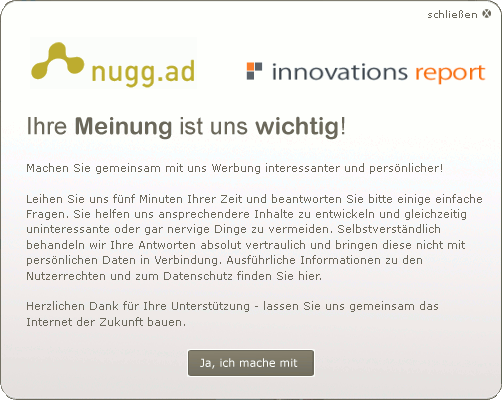Home  Reports
Reports  Physics and Astronomy
Physics and Astronomy  Content
Content
Quantum leap in hi-tech performance
 next article
next article 
26.09.2008
University of Calgary physicists unveil novel process that promises to kick-start quantum technology sector
For years, physicists have been heralding the revolutionary potential of using quantum mechanics to build a new generation of supercomputers, unbreakable codes, and ultra-fast and secure communication networks.
> communication networks > Quantum > quantum computers > quantum devices > quantum mechanics
The
brave new world of quantum technology may be a big step closer to
reality thanks to a team of University of Calgary researchers that has
come up with a unique new way of testing quantum devices to determine
their function and accuracy. Their breakthrough is reported in today's
edition of Science Express, the advanced online publication of the
prestigious journal Science.
"Building quantum machines is
difficult because they are very complex, therefore the testing you need
to do is also very complex," said Barry Sanders, director of the U of
C's Institute for Quantum Information Science and a co-author of the
paper. "We broke a bunch of taboos with this work because we have come
up with an entirely new way of testing that is relatively simple and
doesn't require a lot of large and expensive diagnostic equipment."
Similar
to any electronic or mechanical device, building a quantum machine
requires a thorough understanding of how each part operates and
interacts with other parts if the finished product is going to work
properly. In the quantum realm, scientists have been struggling to find
ways to accurately determine the properties of individual components as
they work towards creating useful quantum systems. The U of C team has
come up with a highly-accurate method for analyzing quantum optical
processes using standard optical techniques involving lasers and lenses.
"It
is a completely different approach to quantum characterization than we
have seen before," said post-doctoral researcher Mirko Lobino, the
paper's lead author. "This process will be able to tell us if something
is working correctly and will hopefully lead the way towards a quantum
certification process as we move from quantum science to making quantum
technology."
The development of quantum computers is considered
the next major advancement in computer processing and memory power but
is still in its infancy. Unlike regular silicon-based computers that
transmit information in binary units (bits) using 1 and 0, quantum
computers use the subatomic physical processes of quantum mechanics to
transmit information in quantum bits (qubits) that can exist in more
than two states. Computers based on quantum physics are predicted to be
far more powerful than computers based on classical physics and could
break many of the most advanced codes currently used to secure digital
information. Quantum physics is also being used to try and create new,
unbreakable encryption systems.
The same research group at the U
of C, led by physics professor Alexander Lvovsky, made headlines
earlier this year when they were one of two teams to independently
prove it's possible to store a special kind of light, called a
"squeezed vacuum." That work is considered the initial step towards
creating memory systems for quantum computing.
Grady Semmens | Source: EurekAlert!
Further information: www.ucalgary.ca
www.sciencexpress.org
Further Reports about: communication networks > Quantum > quantum computers > quantum devices > quantum mechanics
 next article
next article 
More articles from ![]() Physics and Astronomy:
Physics and Astronomy:
![]() Ancient Egyptian Astronomy
Ancient Egyptian Astronomy
17.10.2008 | Waseda University
![]() Listening to dark matter
Listening to dark matter
16.10.2008 | Institute of Physics
B2B Search
Company / Organisation
Latest News
![]() Integrating Transplantation research in Europe : Recent Advances and Future Challenges
Integrating Transplantation research in Europe : Recent Advances and Future Challenges
17.10.2008 | Life Sciences
![]() How was work today? A major study begins into work-related health and well being
How was work today? A major study begins into work-related health and well being
17.10.2008 | Studies and Analyses
![]() Exports may not rescue UK economy
Exports may not rescue UK economy
17.10.2008 | Business and Finance










